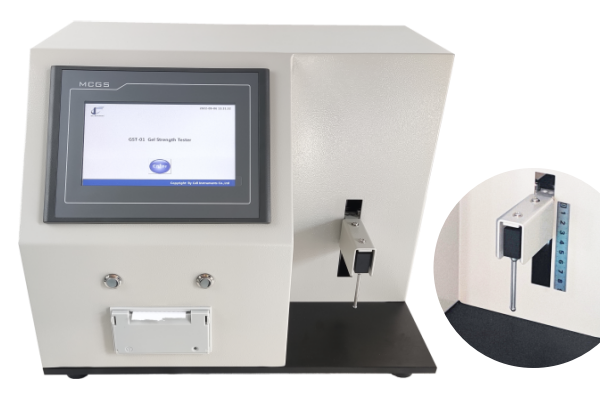Gelatin Bloom Strength Test
The bloom test is an essential analytical method used across the food, pharmaceutical, and packaging industries to determine the gel strength of gelatin and other hydrogels. Accurately measuring gelatin bloom strength not only ensures product consistency but also plays a vital role in quality control and formulation design.
What Is the Bloom Test?
The bloom test is a standardized procedure used to measure the firmness or strength of a gel, typically gelatin, under controlled conditions. It’s named after Oscar T. Bloom, who developed the method in the early 20th century. The bloom value is expressed in grams and represents the force required for a specified probe to depress the surface of a gel by a set distance—usually 4 mm.
A higher bloom value indicates a stronger, firmer gel, which is especially important in applications like capsule production, gummy formulation, desserts, and even photographic films.
Why Gelatin Bloom Strength Matters
Gelatin bloom strength is a key quality attribute for gelatin-based products. Variations in this parameter can lead to inconsistent textures, poor product performance, or compliance failures. For food technologists and pharmaceutical quality controllers, a consistent bloom value means predictable behavior during processing and end use.
Bloom strength testing also supports formulation optimization, helping manufacturers select the right type of gelatin for desired viscosity, gelling temperature, and textural attributes.
Methods to Measure Gelatin Bloom Strength
The bloom strength test is governed by standards such as GMIA, ISO 9665, and USP methods. The most common test protocol involves:
- Preparation of gelatin solution: Dissolve 6.67% gelatin in water and let it gel for 16–18 hours at 10°C.
- Testing setup: Use a standardized 0.5-inch diameter probe.
- Testing parameters: Apply force at a controlled speed (e.g., 1 mm/s) until the probe penetrates 4 mm into the gel surface.
- Result: The peak force (in grams) required for this penetration equals the bloom value.
Advanced testers like the GST-01 Тестер прочности геля offer automated precision control of displacement and force application, ensuring consistent, repeatable results.
Applications of the Bloom Strength Test
The bloom test isn’t just confined to food-grade gelatin. It is widely applied in:
- Pharmaceutical gelatin capsules: Ensures consistent dissolution rates.
- Soft confectionery: Controls texture and chewability of gummies and jellies.
- Cosmetic gels: Ensures viscosity and sensory feel.
- Biomedical hydrogels: Standardizes performance in drug delivery or wound care systems.
Instruments for the Bloom Strength Test: Why Use a Gel Strength Tester?
To measure gel strength accurately, manual methods fall short in precision and repeatability. That’s where a professional тестер прочности геля becomes essential.
The Cell Instruments GST-01 Gel Strength Tester offers the following advantages:
- Accurate and repeatable measurement из peak force, displacement, and load.
- ПЛК-управление with a 7-inch touch screen for intuitive operation.
- Variable speeds (1–100 mm/min) to match different gel types and test conditions.
- Displacement resolution of 0.01 mm, ensuring highly detailed results.
- Multiple fixtures and flexible test programs, ideal for various texture analysis needs.
- Data export and microprinter for efficient reporting.
If you require reliable, industrial-grade gel strength measurement, the GST-01 is a top choice for laboratories and production environments.
Tips for Performing an Accurate Bloom Strength Test
To obtain meaningful results from a bloom strength test, keep these best practices in mind:
- Ensure uniform gelation conditions: Time and temperature significantly impact bloom values.
- Use a calibrated gel strength tester: Instruments like the GST-01 prevent variability due to human error.
- Regularly verify probe and displacement settings.
- Avoid bubbles in the gel during preparation.
- Run multiple samples for statistical accuracy.
The bloom test is indispensable for controlling the gelatin bloom strength of hydrocolloid products. With the right method and instrument, such as the Cell Instruments GST-01 Gel Strength Tester, quality control professionals can ensure consistent, high-quality outputs that meet product performance and regulatory expectations.
For manufacturers seeking high accuracy, automation, and user-friendly operation in bloom strength testing, the GST-01 offers a cost-effective and technically advanced solution tailored to modern testing needs.
Часто задаваемые вопросы
Typical bloom values range from 50 to 300 grams. Higher bloom numbers indicate firmer gels, suitable for applications like capsules or gummy candies.
It measures the force needed to penetrate a gel surface to a specific depth, providing data on peak force, displacement, and load at set conditions.
Yes, the GST-01 supports multiple fixtures and flexible programs, allowing it to test a variety of hydrocolloids and textures.
It affects capsule hardness, disintegration time, and bioavailability, making it a critical quality parameter for gelatin-based drug delivery systems.

